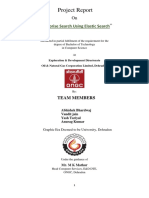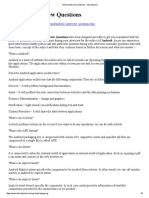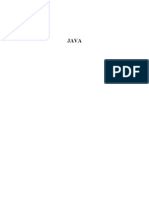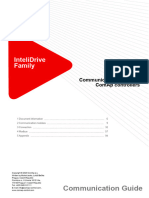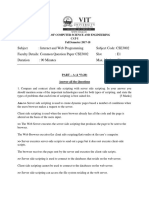C# Web API Cheat Sheet
Uploaded by
Ric Darryl VillaruzC# Web API Cheat Sheet
Uploaded by
Ric Darryl VillaruzC#
Sign Up For An Account
To create a new account through the API, you will need to do the following:
Default API Path: /api/account/register
Call Type: POST
WebAPI Body (raw application/json):
Cheatsheet
{
“Email”: “youremail@test.com”,
“Password”: “TestPwd123?”,
“ConfirmPassword”: “TestPwd123?”
}
Get started with WebAPI
including authentication
calls, basic commands, Get Token (Log In)
and more. To log into your account and get the token to be used on all future calls, per-
form the following call:
Default API Path: /token
HTTP Verbs
Call Type: GET
GET Read Body (x-www-form-urlencoded):
POST Create {
PUT Replace grant_type: password
username: youremail@test.com
PATCH Modify password: TestPwd123?
}
DELETE Delete
Making an Authorized Call
IHttpActionResult Once you have your token, to call an API endpoint that requires authorization,
200 Ok make the following additions to whatever call you make:
Headers
302 Redirect
{
400 BadRequest Authorization: “Bearer <token>“
401 Unauthorized }
404 NotFound
Endpoint Attributes
409 Conflict
To modify an endpoint in some way, you can include one or more of the follow-
500 Exception ing attributes:
[Authorize]
Find Me At Everyone who calls this endpoint must include the bearer token. You can
also limit authorization like so: [Authorize (Roles = “Employees”)]
www.IAmTimCorey.com
[HttpGet]
Specifies the type of HTTP verb required to connect to this endpoint.
Other verb can be used as well (HttpPost, HttpPut, etc.)
[Route(“api/Test/MyRoute”)]
Specifies route used to connect to this endpoint. This overrides the
default. Especially useful for deeper paths or method overloading.
You might also like
- The Node - Js Developer Roadmap For 2021No ratings yetThe Node - Js Developer Roadmap For 20216 pages
- An Introduction To Junit: Animesh KumarNo ratings yetAn Introduction To Junit: Animesh Kumar27 pages
- Lab Instructions N Core Java AssignmentsNo ratings yetLab Instructions N Core Java Assignments10 pages
- Profound Knowledge & Seven Thinking Levels100% (1)Profound Knowledge & Seven Thinking Levels31 pages
- Fundamental Programming Structures in JavaNo ratings yetFundamental Programming Structures in Java23 pages
- GoF Design Patterns Reloaded With Java8No ratings yetGoF Design Patterns Reloaded With Java893 pages
- 83 Core Java Interview Questions and Answers - Freshers, ExperiencedNo ratings yet83 Core Java Interview Questions and Answers - Freshers, Experienced12 pages
- SQL Detailed Notes For Professionals 1672765219No ratings yetSQL Detailed Notes For Professionals 1672765219166 pages
- Introduction To Object Oriented Programming Concepts (OOPS) in C#.Net - ASP - Net, C#.NET, VBNo ratings yetIntroduction To Object Oriented Programming Concepts (OOPS) in C#.Net - ASP - Net, C#.NET, VB9 pages
- Dot NETFramework Notes For ProfessionalsNo ratings yetDot NETFramework Notes For Professionals192 pages
- 37 Essential JavaScript Interview Questions and Answers (2022) Toptal®No ratings yet37 Essential JavaScript Interview Questions and Answers (2022) Toptal®17 pages
- Full Stack Developer JAVA Job Oriented Program SEEDNo ratings yetFull Stack Developer JAVA Job Oriented Program SEED5 pages
- Ultimate Web Automation Testing with Cypress: Master End-to-End Web Application Testing Automation to Accelerate Your QA Process with CypressFrom EverandUltimate Web Automation Testing with Cypress: Master End-to-End Web Application Testing Automation to Accelerate Your QA Process with CypressNo ratings yet
- Security in REST Vulnerabilities and RESTful Security MechanismsNo ratings yetSecurity in REST Vulnerabilities and RESTful Security Mechanisms1 page
- A Guide To Mastering html5 css3 and JavascriptNo ratings yetA Guide To Mastering html5 css3 and Javascript68 pages
- Android Interview Questions - Tutorialspoint100% (1)Android Interview Questions - Tutorialspoint5 pages
- The Roles of Service Mesh and API Gateways in Microservice Architecture - by Tanmay Deshpande - Better Programming - Oct, 2020 - MediumNo ratings yetThe Roles of Service Mesh and API Gateways in Microservice Architecture - by Tanmay Deshpande - Better Programming - Oct, 2020 - Medium7 pages
- ColdFusion Interview Questions, Answers, and Explanations: ColdFusion Certification ReviewFrom EverandColdFusion Interview Questions, Answers, and Explanations: ColdFusion Certification ReviewNo ratings yet
- Create A New Welcome Card On Mobile App BTPNo ratings yetCreate A New Welcome Card On Mobile App BTP13 pages
- Red Hat Satellite 6.0 Installation Guide en USNo ratings yetRed Hat Satellite 6.0 Installation Guide en US34 pages
- Yealink+DECT+Phones+XML+Browser+Developer's+Guide+V1 5No ratings yetYealink+DECT+Phones+XML+Browser+Developer's+Guide+V1 552 pages
- MTA finder - Unified OSINT platform for efficient data gatheringNo ratings yetMTA finder - Unified OSINT platform for efficient data gathering6 pages
- Quick Installation Guide: Connect The HardwareNo ratings yetQuick Installation Guide: Connect The Hardware2 pages
- D Murli - Creating Multilingual Website (English - Hindi - Punjabi) Using ASPNo ratings yetD Murli - Creating Multilingual Website (English - Hindi - Punjabi) Using ASP6 pages
- (Cambridge International AS & A Level) Malcolm Surridge, Andrew Gillespie - Cambridge International AS and A Level Business-Hodder Education (2014)No ratings yet(Cambridge International AS & A Level) Malcolm Surridge, Andrew Gillespie - Cambridge International AS and A Level Business-Hodder Education (2014)1 page
- A Critical Review of Digital Marketing: Cite This PaperNo ratings yetA Critical Review of Digital Marketing: Cite This Paper3 pages
- The AirSensor Open-Source R-Package and DataViewer Web Application For Interpreting Community Data Collected by Low-Cost Sensor NetworksNo ratings yetThe AirSensor Open-Source R-Package and DataViewer Web Application For Interpreting Community Data Collected by Low-Cost Sensor Networks17 pages






















